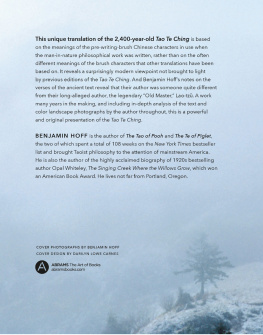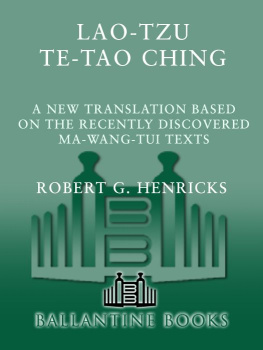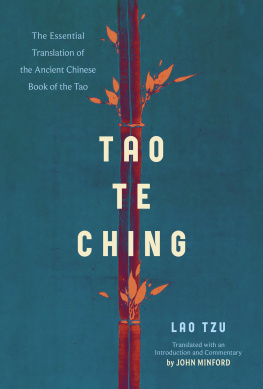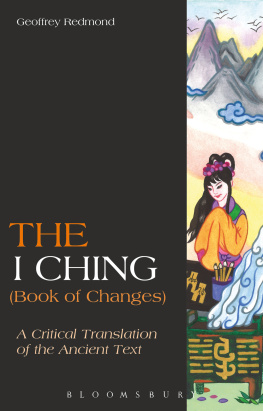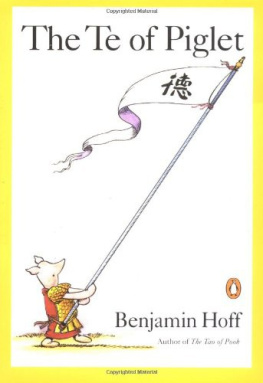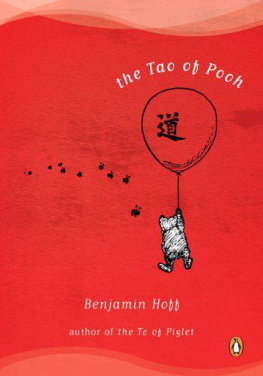Contents
Guide
Page List
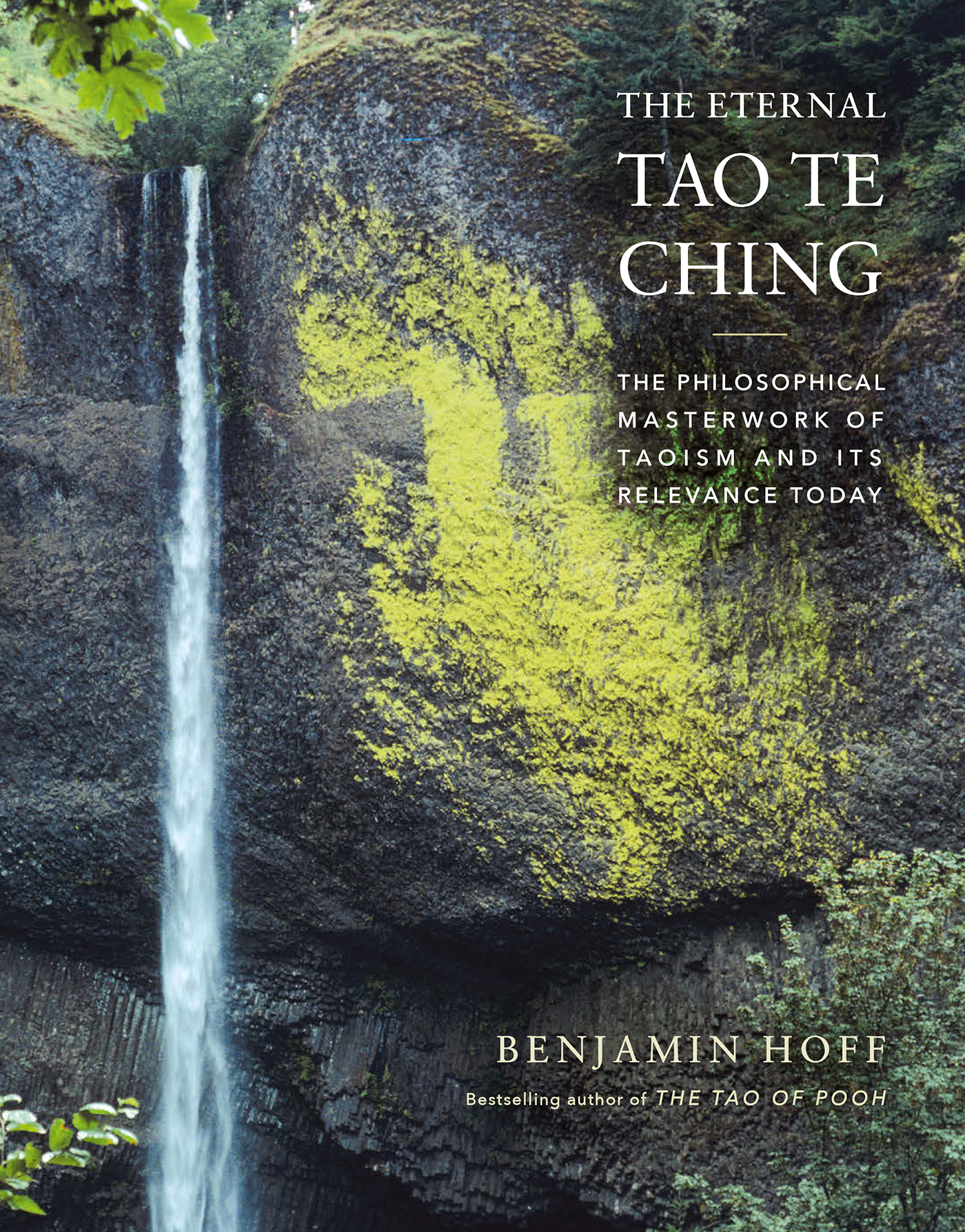
CRYPTIC WRITING, HIDDEN DRAGON
The Chinese spiritual teaching known as Taoism (daoism) has two ages-old traditional forms: tao-chiao, the colorful and complex native religion, and tao-chia, the philosophical (no deified human beings) form that preceded the religion. This book is concerned with the philosophical form.
Philosophical Taoism was brought into existence by a written work that eventually became known as the Tao Te Ching (dao dehr jeeng), the Way Virtue Classic. According to legend, this first and foremost Taoist classic was composed around 500 BCE by a former record keeper in the royal library at Loyang. But, as I explain later, the legendary claims dont match reality.
The verses of the Tao Te Ching look, and are, different from other Chinese writings, old and new. At first glance, they seem very simplesome look like childrens rhymes, and many make use of rhyme intervals, rather like advertising jingles. Until the Communists took control of China and did their best to destroy Taoismand Taoiststhe verses of the Tao Te Ching were chanted in schools as a way to teach and learn the philosophical classic. But their simple, childlike appearance is deceptive.
Behind the simplicity of the statements in the Tao Te Ching lies a profound depth of thought. If philosophical Taoism were a religion, the Tao Te Ching would be its holy book. But the Way Virtue Classic covers more territory than any holy book Ive encountered: It is mystical; it is practical; it is philosophical; it is spiritual; it is individual-oriented; it is society-oriented; it is political; it is ecological; it is simple; it is sophisticated; it is entertaining; it is deep. Some might call its Taoism a systembut one unlike the stiff, heavy-handed system of Confucianism. A Taoist might more accurately call it fluid systems determined by circumstances.
Although there are a great many English-language translations of the Tao Te Ching in existence, in reality they are by necessity interpretations, as is this one.
One reason for this is that the Chinese language is so strikingly different from the English language that for the most part a direct translation would itself need a translationthat is, an interpretation of the translationin order to be intelligible. Another reason is that the author does not consistently use Chinese characters in what would today be considered the classical manner. In some places, he plays fast and loose with them, as though making up a language of his own. Chinese writing could be called a sort of shorthand. But the author often uses characters as a cryptic, minimalist shorthand, and sometimes uses them in the most basic pictographic ways. All of which makes the verse collection a puzzle as well as a work of literature. Deciphering the Way Virtue Classic is rather like finding ones way through a complex maze: With many of the characters, the translator/interpreter has a variety of meanings to choose from, each of which can result in progress or lead to an impasse. And there are other difficulties:
Over the centuries, Chinese scholars copying the Tao Te Ching some-times inserted their own thoughts or other material into the text. Lazy, sloppy, or inadequately educated copyists introduced many errorssome very obvious, others less so. And, as explained in Ancient Pictures, Ghostly Voices, the post-Tao Te Ching advent of the writing brush brought about frequent, sometimes extreme alterations to the meanings of the characters in use when the work was written. Consequently, for accuracy and fairness to the author, a translator/interpreter needs to research and use the original meanings, not merely translate from the more modern brush characters or translate the ancient characters into writing-brush characters and use their meanings.
As far as I can determine from the wording choices in all of the English-language editions in my extensive collection of Tao Te Chings, I am the first English-language translator/interpreterdifficult though it is for me to understand whyto go by the meanings of the ancient characters. The original- meanings approach of this book may make it unique among all editions. I say this because I havent heard or seen evidence of any edition in any country incorporating any of the meanings Ive come across. If other interpreters had made any of those game-changing discoveries, I believe I would have heard or read about it.
The standard Wang Pi (wahng bee) Tao Te Ching text used as an authoritative source by most scholars (and myself) contains what seems the smallest number of errors and tamperingsalthough in my opinion, it contains a great manyand reads the most consistently. Even so, a translator/ interpreter ideally needs to be a linguistic code breaker as well as an author profiler in order to decipher statements anda point about which Im extremely particularto determine which are most likely original and which are most likely the work of others.
At least in my opinion, the important question is not whether a translation/interpretation is perfectly accurate to any Chinese text, because no original has yet been found (all existing old texts are flawed copies) and perfect accuracy has therefore been rendered impossible. The important question is, or should be: What is the author saying? Being scholarly, vital though it is, only takes one so far in deciphering the unique work of writing known as the Tao Te Ching. In addition, one needs a working knowledge of Taoism coupled with empathythe ability to read the authors intent. Following the traditional outside-looking-in scholarly approach to translating and interpreting the Tao Te Ching results in the sort of work that produces a sensible statement here but nonsense there.
Consider the first two statements made in the first chapter (section) of the Tao Te Ching. In classical Wade-Giles romanization, they read:
tao ko tao fei chang tao
ming ko ming fei chang ming
Tao in this case means way, path, or road. Ko means can be. It changes whatever noun follows it into a verb, so the second tao means wayed. Fei is an emphatic not, negative, opposition, contradiction or wrong. Chang means constant, consistent, unchanging or everlasting, eternal. Ming in this context means name or title. So a basic translation would be:
way can be wayed not eternal way
name can be named not eternal name
Filling things out, we get:
[The] way [that] can be wayed [is] not [the] eternal way.
[The] name [that] can be named [is] not [the] eternal name.
The traditional English-language interpretation is:
The way that can be told is not the eternal Way.
The name that can be named is not the eternal Name.
Buttao ko tao does not translate as way can be told; it translates as way can be wayed. Wayed would mean way put into action or way done. How does one do a way, a path, or a roadby telling about it or by following it?
A more appropriate interpretation, I believe, would be:
The Way That Can Be Followed is not The Eternal Way.
The Name That Can Be Named is not The Eternal Name.
Isolated from the rest of the chapter, that interpretation may seem more confusing than the usual one, since the rest of the chapter can help one to realize what the two lines are referring to. Before I give an explanation of that wording, and in so doing explain why I believe that the usual interpretation misses the authors point, Ill say that, to meand, from what Ive read and heard, to many other peoplethe

